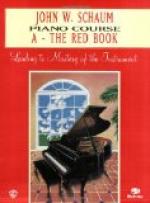We went through the Raff Suite, Op. 94. “The Preludio is very good,” he said; “I like it. The Menuetto is, musically, the least strong of any of the numbers, but it has a certain elegance, and is the most popular of them all. The Romanza is a great favorite of mine, it is very graceful, flowing and melodious. The concluding Fugue is a fine number; you see how the theme is carried from one hand to the other, all twisted about, in a way old Bach and Handel never thought of doing. I consider this Raff fugue one of the best examples of modern fugue writing.”
Mr. Sherwood was fond of giving students the Josef Wieniawski Valse, for brilliancy. “There are many fine effects which can be made in this piece; one can take liberties with it—the more imagination you have the better it will go. I might call it a stylish piece; take the Prelude as capriciously as you like; put all the effect you can into it. The Valse proper begins in a very pompous style, with right hand very staccato; all is exceedingly coquettish. On the fifth page you see it is marked amoroso, but after eight measures the young man gives the whole thing away to his father! The beginning of the sixth page is very piano and light—it is nothing more than a breath of smoke, an airy nothing. But at the poco piu lento, there is an undercurrent of reality; the two parts are going at the same time—the hard, earthly part, with accents, and the spiritual, thin as air. To realize these qualities in playing is the very idealization of technic.”
The Chopin-Liszt Maiden’s Wish, was next considered. “The theme here is often overlaid and encrusted with the delicate lace-like arabesques that seek to hide it; but it must be found and brought out. There is so much in being able to find what is hidden behind the notes. You must get an insight into the inner idea; must feel it. This is not technic, not method even; it is the spiritualization of playing. There are pieces that will sound well if the notes only are played, like the little F minor Moment Musicale of Schubert; yet even in this there is much behind the notes, which, if brought out, will make quite another thing of the piece.
“Schumann’s Andante, for two pianos, should have a very tender, caressing touch for the theme. The place where the four-sixteenths occur, which make rather a square effect, can be softened down. On the second page, be sure and do not accent the grace notes; let the accent come on the fifth finger every time. For the variation containing chords, use the grasping touch, which might be described as a certain indrawing of force in the end of the finger, as though taking a long breath. The variation in triplets seems at first sight almost a caricature, a burlesque on the theme, but I don’t think that Schumann had any such idea. On the contrary he meant it as a very sweet, gentle, loving thought. The last page has something ethereal, ideal about it; it should be breathed out, growing fainter and fainter to the end.




